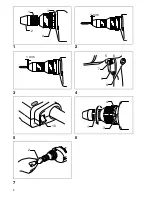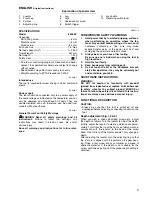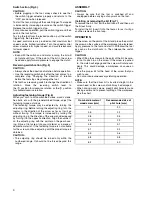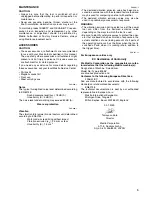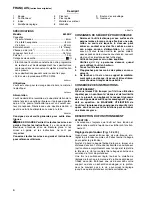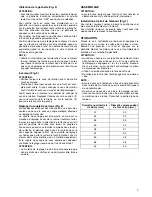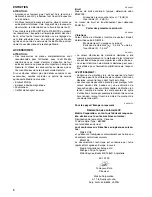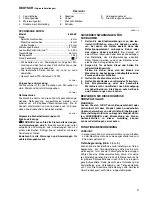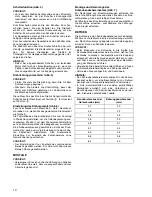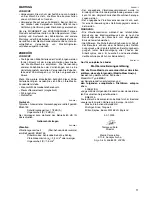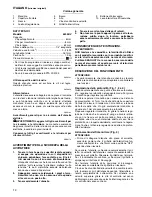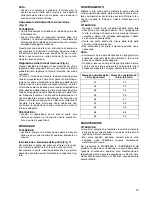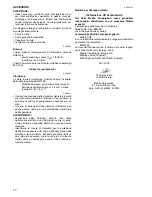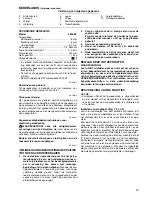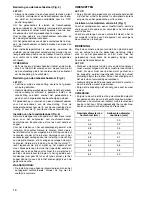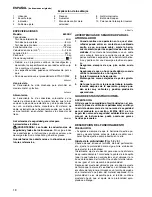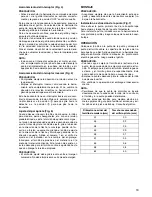
4
Switch action (Fig. 4)
CAUTION:
• Before plugging in the tool, always check to see that
the switch trigger actuates properly and returns to the
“OFF” position when released.
To start the tool, simply pull the switch trigger. Tool speed
is increased by increasing pressure on the switch trigger.
Release the switch trigger to stop.
For continuous operation, pull the switch trigger and then
push in the lock button.
To stop the tool from the locked position, pull the switch
trigger fully, then release it.
A speed control screw is provided so that maximum tool
speed can be limited (variable). Turn the speed control
screw clockwise for higher speed, and counterclockwise
for lower speed.
NOTE:
• Even with the switch on and motor running, the bit will
not rotate until you fit the point of the bit in the screw
head and apply forward pressure to engage the clutch.
Reversing switch action (Fig. 5)
CAUTION:
• Always check the direction of rotation before operation.
• Use the reversing switch only after the tool comes to a
complete stop. Changing the direction of rotation
before the tool stops may damage the tool.
This tool has a reversing switch to change the direction of
rotation. Move the reversing switch lever to
the
i
position for clockwise rotation or the
j
position
for counterclockwise rotation.
Adjusting fastening torque (Fig. 6)
When you wish to drive machine screws, wood screws,
hex bolts, etc. with the predetermined torque, adjust the
fastening torque as follows.
The fastening torque may be adjusted by turning the
adjusting ring. Before turning the adjusting ring, turn the
locator in the direction of the arrow as far as it will go
without forcing. The torque is increased by turning the
adjusting ring in the direction of the arrow and decreased
by turning it in the opposite direction. Align the number 1
on the adjusting ring with the pointer on the gear hous-
ing. Drive a trial screw into your material or a piece of
duplicate material. If the fastening torque is not suitable
for the screw, continue adjusting until the proper torque is
obtained.
CAUTION:
• The adjusting ring should be turned only within the
numbered range. It should not be forced beyond this
range.
ASSEMBLY
CAUTION:
• Always be sure that the tool is switched off and
unplugged before carrying out any work on the tool.
Installing or removing the bit (Fig. 7)
To remove the bit, first pull the front cap off and then pull
the bit out firmly.
To install the bit, insert it into the tool as far as it will go
and then replace the front cap.
OPERATION
Fit the screw on the point of the bit and place the point of
the screw on the surface of the workpiece to be fastened.
Apply pressure to the tool and start it. Withdraw the tool
as soon as the clutch cuts in. Then release the switch
trigger.
CAUTION:
• When fitting the screw onto the point of the bit, be care-
ful not to push in on the screw. If the screw is pushed
in, the clutch will engage and the screw will rotate sud-
denly. This could damage a workpiece or cause an
injury.
• Use the proper bit for the head of the screw that you
wish to use.
• Do not continue unnecessary clutching operation.
NOTE:
• Make sure that the driver bit is inserted straight in the
screw head, or the screw and/or bit may be damaged.
• When driving wood screws, predrill pilot holes to make
driving easier and to prevent splitting of the workpiece.
See the chart.
Nominal diameter of
wood screw (mm)
Recommended size of
pilot hole (mm)
3.1
2.0
3.5
2.2
3.8
2.5
4.5
2.9
4.8
3.1
5.1
3.3
5.5
3.6
5.8
3.8
6.2
4.0


